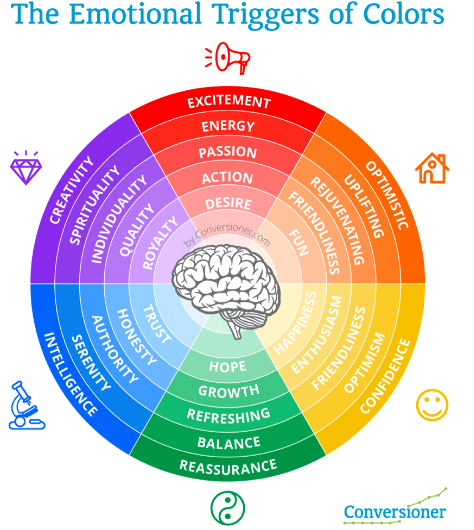Visual branding is an essential component of your marketing toolkit. It refers to the strategic use of visuals to communicate a brand’s values, personality, and messaging to its target audience.
While understanding that visual branding encompasses a comprehensive strategic approach to using visuals for storytelling and conveying brand values, we will specifically zoom in on visual identity.
Visual identity pertains to the specific design elements—such as logos, color palettes, typography, and visual styles—that form the visual cornerstone of a brand’s overall identity.
These elements play a pivotal role in establishing brand recognition, consistency, and emotional connection with the audience.
By focusing on visual identity, we aim to provide actionable insights and tips on how businesses can refine and strengthen their visual presence to effectively communicate their unique identity and resonate with their target market.
This approach enhances brand visibility and reinforces brand loyalty and differentiation in a competitive landscape.
What is Visual Branding?
Visual branding refers to the strategic use of visuals to communicate a brand’s values, personality, and messaging to its target audience.
Visual branding involves creating a cohesive visual experience that aligns with the brand’s overall marketing strategy.
It encompasses not only the visual elements themselves (like logos, colors, typography, and imagery) but also how these elements are used consistently across different channels and platforms to create a recognizable brand image.
Whether you’re a B2B SaaS or a start-up organic snack company, strong visual branding helps you stand out; consistent brand visual identity helps you build relationships with your prospects and customers.
Key Elements of Visual Branding
Key Elements of Visual Branding encompass a range of design elements crucial for establishing and maintaining a distinct brand identity.
These elements include the brand’s logo, color palette, typography, imagery, and overall graphic style. Each component plays a significant role in shaping how a brand is perceived by its audience.
For example, the logo serves as the visual symbol of the brand, instantly recognizable and representing its core values. The color palette not only enhances visual appeal but also evokes specific emotions and associations tied to the brand.
Typography ensures consistency in messaging and enhances readability, while imagery and graphics convey the brand’s personality and resonate with its target audience.
Together, these elements create a cohesive “look” that strengthens brand recognition and fosters deeper connections with consumers across various touchpoints.
The Importance of Visual Branding
How important is visual branding? According to the Pantone Color Institute, 90% of a prospect’s instant decision about a brand can be made based on color alone. A State of Brand Consistency Report revealed that consistent branding can increase revenue by 33%.
Building brand recognition
The core concept of Pre-suasion by marketing and psychology expert Robert Cialdini is that you can make prospects sympathetic to your message before they experience it.
In this way, visual branding, like brand awareness, lays the groundwork for future targeted efforts by helping to get a prospect to know, like, and trust you. However, prospects will not make the connection if your visuals are inconsistent.
Differentiating from competitors
Many industries suffer from a sameness among the competitors in a vertical, like promising to “save time and money.”
Create a professional image using visual elements to disrupt your category with a completely different look, color scheme, and tone.
That’s how you set yourself apart. A perfect example is Astro Nomical, the adorably cuddly mascot from Salesforce.
What Is a Good Visual Identity?
A good visual identity is consistent, adaptable to different uses, from branded water bottles to landing pages, and emotionally connects with your target audience.
Consistency across all platforms
Having visual branding standards is one thing. Enforcing them is another. After developing your brand standards, the first step is ensuring that your entire organization uses them consistently.
Many of today’s tools, even Canva, allow you to set up a brand kit.
Consistency means when someone sees your webinar, social post, or retargeting ad, they immediately recognize it came from your company.
Adaptability and scalability
Include logos, colors, fonts, and guidance on using the brand assets in different channels in your digital brand standards guide.
You risk killing your visual branding momentum if you don’t create visuals that work on various mediums and scales.
Emotional connection
Visuals can evoke the right emotions in your target audience. For instance, you can leverage emotional marketing strategies like choosing colors that align with trustworthiness (blue, for example) to help prospects perceive you as trustworthy. Or you can infuse orange into your palette to communicate playfulness and creativity.

Visual Branding Process
Where do you start when creating or updating your visual branding? Start your journey with research. Explore your competitors, then get outside your business vertical.
Check out your favorite brands to find examples of strong brand identity, especially those that use a blue ocean strategy to stand out from competitors.
Developing your visual identity
Developing your visual identity can be daunting without skilled guidance from experts on color theory and design trends.
An expert designer, like the ones on the WriterAccess platform, can help you create a modern visual identity that uniquely represents your brand.
Start by communicating your unique selling proposition (USP) to a designer who will create initial design concepts, including a color palette, typography, a new or refreshed logo, and visual examples.
Visual and graphic elements within a brand guide help guide your “look.” Will you use only photos of people at play, manga-style avatars, or icons? Give your creatives the freedom to be flexible while ensuring prospects still recognize your visual branding.
Develop an understanding of color theory and its impact on consumer behavior. Choose colors that best represent your brand while being perceived as modern and contemporary. Color trends change just like fashion, so ensure you’re on the leading edge of a color trend.
Then, work with your skilled designer to refine those options into one working set of visual branding that ultimately will become the backbone of your visual identity.
Implementation and testing
Implement as many visual branding elements as you can as quickly as possible. Start with your most highly visible assets, like your website, packaging, social media headers, best-performing content, and ads.
Decide which assets need updating and which can stay with the “old branding.” During the initial rollout, be open to feedback and changes. Build a clear feedback system to make it simple for stakeholders to share.
Be flexible and evolve your visual branding as needed. Mix and match to extend your “look.” A palette of 5 colors can be mixed into 10 different pairs or trios of color combinations.
Maintaining Visual Branding in Content Marketing
Integrate your visual branding into all your content creation moving forward. A well-developed visual identity can remain relevant for a long time.
New CMOs often change branding sooner than necessary to place their stamp on an organization. However, new visual branding may be unnecessary, or worse, as was the case with the Gap’s disastrous new branding effort that lasted 6 days.
Brands that stay attuned to the times know when to change, just like doing a content refresh. If your visual identity starts feeling dated and no longer representative of the essence of your company, it may be time to explore recapturing your relevance with a fresh look.
Storytelling Through Visuals
Fresh visual elements can help tell your brand’s story and resonate with your audience using more modern colors, imagery, and tone.
If you and your team haven’t yet infused strategic storytelling into your marketing toolkit, now is the time. Renowned StoryBrand author Donald Miller describes its importance as “Everybody wants to be taken somewhere.
If we don’t tell people where we’re taking them, they’ll engage with another brand.”
Visual Branding Examples to Get Inspired
Need some additional inspiration to get started? Check out these three brand identity examples.
Apple
Apple could deliver a masterclass in visual branding. At the time of their iPod launch, when tech went complex, Apple went simple.
Apple stood out visually and made their brand “cool” by making earbuds white and products in color (not tepid tan or boring black).
Apple even made the unboxing a unique experience in that bright white box engineered to fit tight and open with a slight “whoosh” noise.
Every piece of content, from their boxes to their web pages, immediately lets you know it was Apple because of the type, tone, and white space. And they’ve mostly kept that look throughout their ecosystem for 15+ years.
McDonald’s
The iconic fast-food chain, known for its golden arches, has maintained its color palette of red and yellow for decades. Why? Because red and yellow make you hungry.
McDonald’s maintains its visual brand identity across its 41,000+ locations, having modernized their look through modest logo changes and font styles over time.
HubSpot
Brands without colossal awareness budgets can still own a space with strong visual branding, like HubSpot. The familiar HubSpot logo with the coral-orange sprocket for an “o” is easily identifiable to marketers.
This logo has remained essentially unchanged since its inception in 2006. According to Similarweb, HubSpot uses a massive amount of helpful, visually consistent blog content to generate over 8 million monthly views.

Additional Tips for Effective Visual Branding
First, resist the temptation to pack too much into any one design. Remember, a confused mind doesn’t buy. Keep it simple.
Secondly, know who you are and what you stand for before building your visual identity. A quality designer will be able to reflect that in your visual identity.
Accelerate your process by finding an expert like the designers at WriterAccess who can guide you. As marketing guru and ClickFunnels founder says, “It’s not the how; it’s the who.”
Visual Branding FAQs
What is visual branding?
Visual branding is the term used to describe all the visual pieces representing your brand identity that work together to support your USP and value proposition.
What are the visual elements of branding?
The core visual elements of branding include your logo, color palette, type font, and visual imagery.
What makes a good visual brand?
A good visual brand perfectly reflects the core personality of a business or business unit. It simply and elegantly appeals to the ideal customer while repelling those outside the target audience.
What are the visual branding techniques?
Visual branding techniques represent the process of building a comprehensive brand guideline for all company visuals, including logo, color palette, typography, images and graphics, and templates.
What is the power of visual branding?
The power of visual branding is its ability to influence prospective buyers. It’s a critical part of a first impression. Through color choice and consistency, companies can get prospects to know, like, and trust them before ever making a sale.
Final Remarks
Visual branding is a powerful tool that can distinguish your business in a crowded market, create a lasting impression on your audience, and drive brand recognition and loyalty. Here are some key points to keep in mind:
- Key elements such as color palette, typography, and imagery must be used consistently across all platforms to ensure a cohesive brand identity.
- The importance of adaptability, emotional connection, and strategic implementation of these elements cannot be overstated.
- It’s clear that high-quality, visually appealing content plays a crucial role in conveying your brand’s story and values.
- Integrating strong visual elements into your content marketing efforts not only enhances engagement but also reinforces your brand’s identity.
To elevate your visual branding and content creation, leverage the expertise available at WriterAccess. Connect with talented designers and content creators to bring your brand vision to life.
Start your journey today and enjoy your first two weeks for free!







